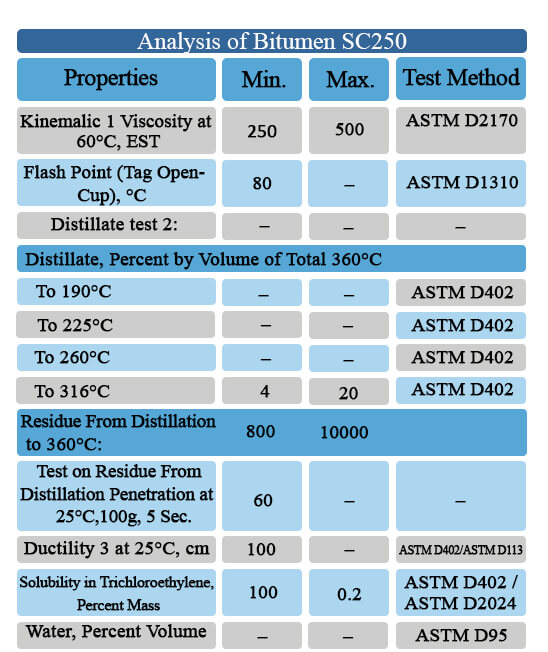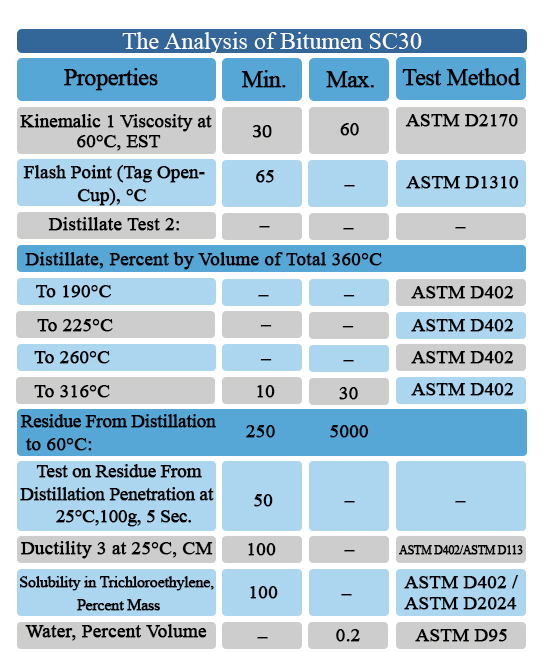What is Cutback bitumen slow curing SC?
The invention relates to bitumen cutback, in particular to the use of fatty acid esters as bitumen cutback agents. These bitumen cutback agents may also be described as cutters, cutback additives, bitumen solvents, or bitumen thinners.
Cutback bitumen
Bitumen is a viscoelastic mix of hydrocarbons used to hold together aggregates in pavements. It is a highly viscous waterproof adhesive at ambient temperatures. Bitumen is generally sourced as a fraction from the distillation of crude oil, but may also be found in natural deposits. One way to use bitumen in road pavements is to spray the bitumen at elevated temperatures onto the road pavement substrate and then to apply stone chips (generally single sized aggregates) to the bitumen surface. This is variously known as bitumen spray sealing, bitumen seal coating, chip sealing or surface dressing. This can be contrasted with hot-mix or asphaltic concrete applications where bitumen and the aggregate are mixed together and then applied to a substrate. In cold-mix (or plant-mix) applications highly cutback bitumen and aggregate are mixed together at ambient temperatures and then applied to a substrate. In many countries kerosene and other volatile petroleum derived products are added as a cutter or a cutback agent to bitumen to reduce (or cutback) the viscosity of the bitumen. The mixture obtained may be called cutback bitumen.
Cutback asphalt
The reduction in viscosity of the bitumen aids the construction of seal coats in road pavements as the softened mixture wets the chips more easily. The cutback agent evaporates from the seal coat, the cutback agent becoming a negligible component of the seal coat a few months after application. If significant amounts of the cutback agent remain in the seal coat an unwanted long term softening effect may result. Cutback agents are also used to lower the viscosity of bitumen when it is applied as a primer to the surface of a road pavement aggregate base course or substrate. The primer penetrates into the surface of the base course and provides a more bitumen friendly surface. Improved adhesion to the base course of a subsequently applied seal coat or hot mix is obtained. The primer may also serve to assist in waterproofing the base course layer.
Kerosene is used as a bitumen cutback agent at different concentrations according to local conditions and requirements. In Iran cutback bitumen for use in bitumen spray sealing or bitumen seal coating typically contains 2 to 5 % (w/w) of kerosene. In cutback bitumen for use as a primer 10 to 15 % (w/w) of kerosene may be used. There are several disadvantages associated with this use of kerosene for bitumen cutbacks. For example, the cutback bitumen is hazardous in use. Spray sealing or seal coating at 150C to 165C is well above the flash point of the cutback bitumen. In addition, evaporation of kerosene into the atmosphere is environmentally harmful. It is estimated that around 2000 to 4000 tons of kerosene is released into the environment each year in Iran alone. The odours emanating from the cutback bitumen are unpleasant and the kerosene is derived from a non-renewable resource.
Cutback bitumen agents
In order to address these disadvantages of conventional bitumen cutback agents, it is possible to use bitumen-water emulsions. After spray- application to the substrate the emulsion breaks and the water evaporates or runs off the surface. However, this process happens slowly (especially in cold weather or in shaded areas) and the applied bitumen emulsion is vulnerable to wet weather until the emulsion has broken.
< If heavy rain falls shortly after application and before the emulsion has broken the emulsion can be washed from the road surface. This causes further expense through the need to relay the surface. It also causes environmental damage as the bitumen is washed away and enters waterways. Extender oils (commonly known as fluxes) and waxes are also used in bitumen spray sealing and hot-mix applications. Extender oils and waxes are distinct from cutback agents. Extender oils and waxes are used to modify the mechanical properties of the applied bitumen layer for extended periods of time, up to the life of the pavement in some applications. Extender oils and waxes remain as a component of the bitumen following application and setting of the seal coat or hot mix. The extender oils or waxes may simply solidify within the bitumen as the bitumen sets or may become cross-linked. Catalysts may be used to promote crosslinking. However, these catalysts may also promote oxidation of the bitumen and an undesirable hardening. In some applications, it is desirable to produce a seal coat with softer bitumen. Extender oils and waxes can be used for this purpose because they remain in the bitumen after the application and setting of the seal coat or hot mix. It is an object of the invention to provide an improved bitumen cutback agent, or at least to provide the public with a useful choice.
General description of cutback asphalt SC250
Cutback bitumen SC250 is dissolved of bitumen in solvents of kerosene. In many countries kerosene and other volatile petroleum derived products are added as a cutter or a cutback agent to bitumen to reduce (or cutback) the viscosity of the bitumen. The mixture obtained may be called cutback bitumen.
The reduction in viscosity of the bitumen aids the construction of seal coats in road pavements as the softened mixture wets the chips more easily. The cutback agent evaporates from the seal coat, the cutback agent becoming a negligible component of the seal coat a few months after application. If significant amounts of the cutback agent remain in the seal coat an unwanted long term softening effect may result.
Uses of cut back asphalt SC250
Cutback agents are used to lower the viscosity of bitumen when it is applied as a primer to the surface of a road pavement aggregate base course or substrate. Kerosene is used as a bitumen cutback agent at different concentrations according to local conditions and requirements.
The cutback bitumen is ideal for prime coat and cold applied because of easy uses and no need to thinning and heating.
Cutback bitumen SC250 consist of the initial incorporation of asphalt into the surface of non-asphalt based course preparatory to any superimposed treatment of construction.
The cutback asphalt SC250 applying to the waterproofing of surfaces, plug capillary voids, coat and bond loose mineral particles.
Packing of cutback bitumen SC250
Packing of cutback bitumen SC250 is in new thick steel drum on pallet to prevent any leak inside of the container also bulk in isotainer and tanker.
We guarantee the quality of the cutback SC250 with arrangement of international inspector to check the quality and quantity of the bitumen on each shipment during the loading to vessel and controlling the production by QC team via batch test report before shipping. Eagle petrochem guaranty the quality to meet with ASTM/EN 15322:2009
Analysis of bitumen SC250:

Cut Back Asphalt SC70
Cutback bitumen SC70 is dissolved of bitumen in solvents of kerosene. In many countries kerosene and other volatile petroleum derived products are added as a cutter or a cutback agent to bitumen to reduce (or cutback) the viscosity of the bitumen. The mixture obtained may be called cutback bitumen.
General description of cutback asphalt SC70
The reduction in viscosity of the bitumen aids the construction of seal coats in road pavements as the softened mixture wets the chips more easily. The cutback agent evaporates from the seal coat, the cutback agent becoming a negligible component of the seal coat a few months after application. If significant amounts of the cutback agent remain in the seal coat an unwanted long term softening effect may result.
Uses of cut back asphalt SC70
Cutback agents are used to lower the viscosity of bitumen when it is applied as a primer to the surface of a road pavement aggregate base course or substrate. Kerosene is used as a bitumen cutback agent at different concentrations according to local conditions and requirements.
The cutback bitumen is ideal for prime coat and cold applied because of easy uses and no need to thinning and heating.
Cutback bitumen SC70 consist of the initial incorporation of asphalt into the surface of non-asphalt based course preparatory to any superimposed treatment of construction.
The cutback asphalt SC70 applying to the waterproofing of surfaces, plug capillary voids, coat and bond loose mineral particles.
Analysis of bitumen SC70

General description of cutback asphalt SC30
Cutback bitumen SC30 is dissolved of bitumen in solvents of kerosene. In many countries kerosene and other volatile petroleum derived products are added as a cutter or a cutback agent to bitumen to reduce (or cutback) the viscosity of the bitumen. The mixture obtained may be called cutback bitumen. The reduction in viscosity of the bitumen aids the construction of seal coats in road pavements as the softened mixture wets the chips more easily. The cutback agent evaporates from the seal coat, the cutback agent becoming a negligible component of the seal coat a few months after application. If significant amounts of the cutback agent remain in the seal coat an unwanted long term softening effect may result.
Uses of cut back asphalt SC30
Cutback agents are used to lower the viscosity of bitumen when it is applied as a primer to the surface of a road pavement aggregate base course or substrate. Kerosene is used as a bitumen cutback agent at different concentrations according to local conditions and requirements.
The cutback bitumen is ideal for prime coat and cold applied because of easy uses and no need to thinning and heating. Cutback bitumen SC30 consist of the initial incorporation of asphalt into the surface of non-asphalt based course preparatory to any superimposed treatment of construction. The cutback asphalt SC30 applying to the waterproofing of surfaces, plug capillary voids, coat and bond loose mineral particles.
Analysis of bitumen SC30:

Comments Off on Cutback bitumen slow curing (SC) with 606 visit